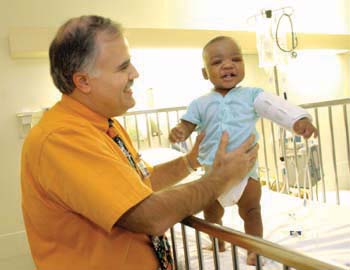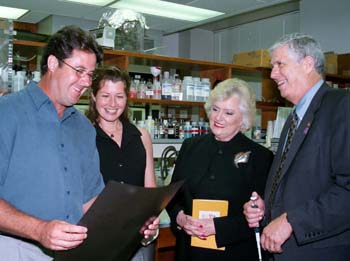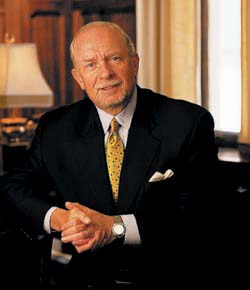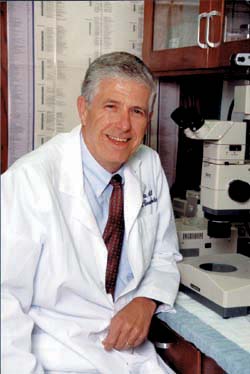
Dr. Haydar Frangoul visits with Jalen Johnson soon after he became one of the first patients at Vanderbilt to undergo an umbilical cord blood transplant. Frangoul is one of more than 100 physicians and scientists recruited to Vanderbilt-Ingram Cancer Center since its inception.
Top 10 cancer center began in a closet

Vince Gill and Amy Grant joined Frances Preston and Dr. Hal Moses for a tour of the laboratories supported by the T.J. Martell Foundation that bear Preston's name.

Jacobson

Moses
When U.S. News & World Report released its Best Hospitals rankings last week, Vanderbilt-Ingram Cancer Center had accomplished its own version of Dean Steven Gabbe’s “10 by 10” challenge.
Orrin Ingram, chairman of the VICC’s Board of Overseers, called the ranking of Vanderbilt at No. 10 on the newsmagazine’s list of the best places to receive cancer care “a remarkable achievement for a cancer center that is only 10 years old.”
Indeed, it’s a long way from a fledgling center with two official employees (Dr. Hal Moses as director and Susan Mills as administrator) and office space in a renovated closet on the 8th floor of what is now the Robinson Research Building.
“Hal Moses has put together a fantastic team, and they’ve accomplished an incredible amount in a short period of time,” said Dr. Harry R. Jacobson, vice chancellor for Health Affairs. “We also owe a great deal to the vision and leadership of Dr. Ike Robinson, Orrin Ingram and the many friends in the private sector who have been willing to invest substantially in the work of the cancer center.”
While Vanderbilt had long conducted landmark cancer-related research and provided the latest in therapy for cancer patients, the Vanderbilt Cancer Center as such wasn’t born until 1993. Moses was named director. His charge: to join the list of elite cancer centers across the country designated by the National Cancer Institute (NCI), the world’s authority on cancer.
Since that time, the center has grown in size, scope and stature.
The initial goal to become NCI-designated was accomplished in 1995; in 2001, the center became one of only 39 to achieve the NCI’s highest designation, as a Comprehensive Cancer Center, the only one in Tennessee.
More than 1,000 physicians and scientists have been recruited, many with start-up packages and endowed professorships augmented with key private support. Since the mid-1990s, clinical volume has grown an average of 7.25 percent each year, and the number of new cancer cases, an average of 12 percent each year.
Competitive research funding from the NCI – an indicator of quality and innovation of research – has grown five-fold since 1994 (from less than $8 million to more than $42 million per year). And the growth of the center has included creation of two new academic departments, Radiation Oncology and Cancer Biology; development of one of the strongest population-based research programs in the country; an innovative partnership with Meharry Medical College; and initiation of a growing Pain & Symptom Management Program.
The U.S. News “Best Hospitals” rankings are but one indicator of success – and one that Moses takes a bit with a grain of salt. “If you watch these rankings year to year, there is always some fluctuation,” he said. “There is no one definitive ranking of cancer centers, but when you take this into account with other measures, they all reflect the progress that we are making.”
Among other achievements:
• Their peers are increasingly calling Vanderbilt-Ingram scientists and physicians to leadership positions in the cancer field. For instance, in 2004, VICC leaders will serve as presidents of three major professional organizations: Lynn Matrisian, Ph.D., with the American Association for Cancer Research; Dr. David Johnson with the American Society of Clinical Oncology; and Moses with the Association of American Cancer Institutes. In addition, Moses is a participant in the National Dialogue on Cancer, an initiative by former President Bush and his wife Barbara to guide the nation’s fight against cancer. Ingram serves as a member of the Dialogue’s CEO Roundtable to involve key corporate leaders in the discussion.
• The NCI has awarded VICC teams two Specialized Programs in Research Excellence (SPOREs), one focused on lung cancer led by Dr. David Carbone and another focused on gastrointestinal cancer led by Dr. Robert Coffey. Competition for the multi-million-dollar grants is great, and they are only awarded to centers that are doing truly innovative research with potential for improving patient care. In the coming weeks, VICC is anticipating award of a third SPORE, in breast cancer, to be led by Dr. Carlos Arteaga. Only seven of the 24 institutions that have SPOREs have three or more such programs.
• The VICC has continued to build strength in basic science as well as focus on translational research, which bridges laboratory discoveries with clinical advances. Just two specific examples: research to understand the role of the epidermal growth factor family of receptors and the cyclooxygenase-2 (COX-2) enzyme in cancer development and progression, and the potential for targeting these pathways to treat and prevent cancer. VICC scientists, including Drs. Arteaga and DuBois, are internationally known and recognized for their landmark work in these important areas. This research has helped lead to the study of aspirin-like COX-2 inhibitors (like Celebrex and Vioxx) to fight cancer and EGFr inhibitors (like the recently approved Iressa) for lung and other cancers. Central to this work is a strong clinical trials program, offering about 150 studies at any one time and including one of the nation’s leading Phase I programs to conduct the very first patient studies of novel drugs.
Behind all of these and other achievements, Moses said, has been tremendous philanthropic support starting with such early initiatives as the A.B. Hancock Laboratory and the Henry-Joyce Cancer Clinic. In 1999, to honor the contributions of the late Bronson Ingram and to recognize a generous gift from the Ingram Charitable Fund, the center was renamed Vanderbilt-Ingram Cancer Center. That lead gift launched the Imagine A World Without Cancer campaign and in 2002, the VICC celebrated topping $150 million and set a new goal of $175 million.
Other important private support has included a 10-year relationship with the music industry and specifically the T.J. Martell Foundation, which supports the Frances Williams Preston Laboratories; the establishment of the Robert J. Kleberg, Jr. and Helen C. Kleberg Center for Cancer Genetics and Genomics; and The Kresge Foundation’s Science Initiative Challenge to help make Vanderbilt a world leader in the study of proteomics and the development of targeted therapies.













